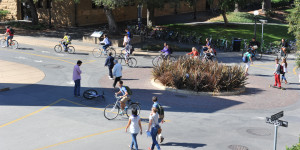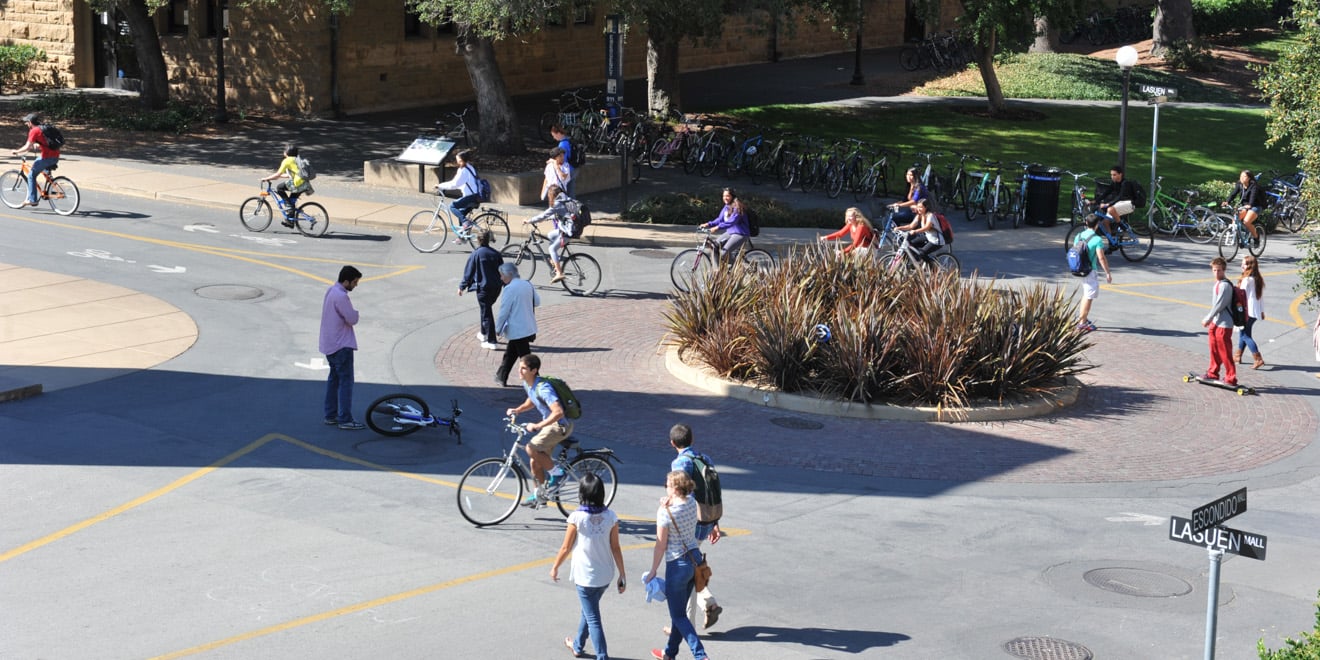
“Everyone else was running the stop signs! Why did you pick on me?”
This is a question commonly asked by students right before getting ticketed for biking through a stop sign on campus, according to Santa Clara County Sheriff’s Deputy Allen James. The answer: the Anchovy Effect.
The Anchovy Effect, a term coined by James himself, means that, just like anchovies, bicyclists often travel in packs, which prevents police from stopping everyone who violates a traffic law.
“Anchovies survive because there are so many of them, and the predator can only catch a few,” James said. “But the message gets out to the other people too, because the people who don’t get caught see you sitting out there, getting a ticket, and that is a form of education in and of itself.”
Still, in the past year, 1,311 citations have been given on campus for failure to stop at a stop sign, according to law enforcement records technician Lydia Morgan-Herman of the Stanford University Department of Public Safety (SUDPS).
Spreading the word through education
James said that because the police would much rather educate students on bike safety laws than force them to pay fines, he started a bicycling equivalent of traffic school seven years ago along with Ariadne Scott, the Parking and Transportation Services biking coordinator. The Bike Diversion Program holds one-hour classes three to four times a month to promote bike safety and provide an economical alternative to paying a hefty fine.
Public Information Officer Bill Larson, who is in charge of crime prevention and community safety, said that the classes help students understand the reasoning behind traffic laws.
“Education does include enforcement,” Larson said. “But it also includes an opportunity for us to talk to a student or anybody who we stop for a bike violation about why they’re getting this bike citation.”
Katie Dudley ’18 was ticketed for running a stop sign recently and originally thought she would have to pay the $200 fine.
“There was only one class offered within the 30 days that I had to do it, and I couldn’t miss practice for it,” she said. “So I emailed them, and they said the best they could do is just give me a chance to do it in the next class.”
Noting that the 4 p.m. class time makes it difficult for athletes to attend, she said she was lucky that she had practice off the day of the next class. Dudley encouraged her friends to avoid the hassle of dealing with the ticket by following the traffic laws.
“Them knowing how much of a struggle I’ve had to go through dealing with it makes them be safer and not want to get a ticket,” she said. “But rarely any bikes actually stop, so I’ll be stopping while all my friends are just like, ‘Why are you stopping?’ and I’m just like, ‘I can’t get another ticket.’”
Spreading the word about bike safety is one of the main goals of the class, according to James.
“We hope that you will be a steward for good behavior and to go out and help your friends be safer and better citizens of the community,” he said.
Emphasis on helmet wearing
Since 2008, over 6,000 people have participated in the Bike Diversion Program, James said. As enforcement efforts have stepped up, class sizes have risen from 10 to 20 people per class to around 50, according to James. Though the class is typically comprised of students who have received tickets, anyone can come to learn more about bike safety and laws.
“I would recommend that any student that wants to be a safer bicyclist and protect his or her investment that they have made in their education [come],” James said. “Because if you think of your cell phone, would you carry your iPhone around without that protective covering?”
James said that one of the most impactful parts of the program focused on wearing helmets. The class has received funding for free helmets, and by the end of each session, James tries to get a few people to pledge to wear helmets when bicycling.
“Yeah, it makes me look a little dorky, it’s hard to carry, and it’s a pain,” he said. “But the benefit is, if somebody hits me and I can’t do anything about it, it may just very well save my Stanford education.”
Larson said that the class does more than just talk about hypotheticals — James and Scott have brought in trauma surgeons to share their real-world stories.
“They come in and talk about people they’ve operated on [that] ended up with traumatic brain injuries,” Larson said.
Goals for the program
James said he would like to see more students have easy access to the course material, which is why he hopes for it to some day become a mandatory pre-orientation class to accompany the alcohol and sexual assault education courses or even a mandatory part of New Student Orientation.
“Since we haven’t been able to be officially added to NSO, we’re going to try to get something online within the next year or so,” James said.
Expanding the reach of the Bike Diversion Program is important, James said, because a little education can go a long way in making sure bicyclists follow traffic laws and ride safely.
“We can’t catch them all,” James said. “There’s only a few of us and a few hundred bicyclists out there. So just hope you’re not the caught anchovy.”
Contact Tristan Vanech at tvanech ‘at’ stanford.edu.
